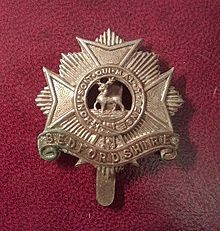16th Foot
| 16th (Bedfordshire) Regiment of Foot The Bedfordshire Regiment The Bedfordshire and Hertfordshire Regiment |
|
|---|---|

Badge of the Bedfordshire Regiment (c. 1914–1918)
|
|
| Active | 1688–1958 |
| Country |
|
| Branch |
|
| Type | Infantry |
| Role | Line infantry |
| Garrison/HQ | Kempston Barracks, Kempston |
| Nickname(s) | The Old Bucks; The Peacemakers; The Featherbeds; Old Sixteen |
| Colours | Deep yellow facings until 1881, white thereafter |
| March | The Mountain Rose until 1882, La Mandolinata from 1882 |
| Anniversaries | Blenheim Day, August (The Battle of Blenheim, 1704) |
| Engagements | Nine Years War, War of the Spanish Succession, American War of Independence, Second Boer War, First World War, Second World War |
The Bedfordshire and Hertfordshire Regiment was the final title of a line infantry regiment of the British Army that was originally formed in 1688. After centuries of service in many small conflicts and wars, including both the First and Second World Wars, the regiment was amalgamated with the Essex Regiment in 1958 to form the 3rd East Anglian Regiment (16th/44th Foot). However, this was short-lived and again was amalgamated, in 1964, with the 1st East Anglian Regiment (Royal Norfolk and Suffolk) and 2nd East Anglian Regiment (Duchess of Gloucester's Own Royal Lincolnshire and Northamptonshire), and the Royal Leicestershire Regiment to form the present Royal Anglian Regiment.
The origins of the regiment go back to 9 October 1688 when the raising of Archibald Douglas' Regiment of Foot was authorised by King James II in response to the threat posed to his throne by Prince William of Orange. The regiment was raised in the southern counties of England, and was embodied in Reading, Berkshire. The new regiment was ordered to London to oppose William's forces, but refused to fight. James fled the country, allowing William to become king. Colonel Douglas, an adherent of the displaced monarch, was replaced by Robert Hodges and the regiment was allowed to continue in existence as part of William's army.
The installation of William as king involved England in the wider Nine Years War. The regiment quickly embarked for service overseas in April 1689, forming part of the Anglo-Dutch forces in the Netherlands. They fought at the battles of Walcourt (1689), Steenkirk (1692) and Neer Landen (1693). In 1695 they took part in the siege and capture of Namur and remained in Flanders until the Treaty of Ryswick ended the war in 1697.
...
Wikipedia
